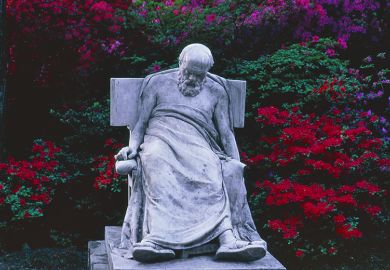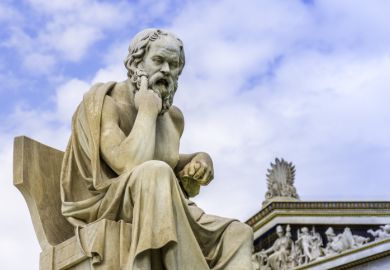Embarking, over a holiday, on Martha Nussbaum's huge book, I was reminded of a summer holiday some 45 years ago when I was obliged to read for the first time Jean-Paul Sartre's Being and Nothingness , then newly translated into English and about to become, though marginally, part of the English philosophical scene. Both books are daunting; both are magpie pickings of other people's insights, put to work for the ideological purposes of the author; both have a strong moral and political intent.
The similarity does not end there. The fusing of cognition with emotion, the main theme of Nussbaum's book, was a fundamental insight of phenomenology, whose founding father was Franz Brentano and whose most important exponent was Edmund Husserl. Sartre, an early and enthusiastic disciple of Husserl, was convinced by him that one cannot separate the emotions from the intellect, that the emotions have objects (they are intentional) and that loving or hating or feeling disgust for an object is a way of perceiving that is bound up in all our understanding and knowledge of the world, giving intelligibility to that world. Sartre went to Germany in 1938 to study Husserl's work and came back with an excited message: "So it is that all at once hatred, love, fear, sympathy - all these famous 'subjective' reactions which were floating in the malodorous brine of the mind - are pulled out. They are merely ways of discovering the world."
Nussbaum's message is the same. Emotions are ways in which we direct our attention to objects, not to be separated from perception or cognition. Brentano, however, is mentioned by her in one footnote; Sartre, scornfully, in another; and Husserl not at all.
If her main thesis is not as novel as she appears to think, Nussbaum's way of presenting it, and the texts she chooses for analysis and criticism, are striking and original. She begins by exploring an emotional experience of her own, the sudden illness of her mother in the US, while she herself had flown over to lecture at Trinity College, Dublin, whence she had to fly back not knowing whether she would find her mother alive or dead. The grief she felt on finding that her mother had died is the starting point for her account of the emotions. She gives her account the title "Neo-stoicism", since she finds in the ancient Stoics the general belief that the emotions are, or contain, value judgments of things that lie outside our own control. They also held that such judgements were false, and that therefore emotion must as far as possible be expunged if a true value is to be attached to events in the world; but this attitude to emotions is far from Nussbaum's own. The structure of the book is determined by a gradual refinement of the Stoic idea.
In pursuit of this refinement, the Stoic view is changed in the light of a consideration not only of some philosophical accounts of the emotions, but of novelists, anthropologists and psychoanalysts. Among philosophers, her preferred exponents are Plato, Aristotle and Spinoza. Her theory that emotions are crucial in shaping not only our own inner life, but our life as members of a particular society with its own culture, is illustrated especially by an account, drawn largely from the work of the British psychiatrist A. W. Winnicott, of the development of the human infant's recognition of objects in the world and his essential needs. That emotions have their roots in infantile experience of the world is one important source of the modification of the original Stoic view: because of their submerged origins, emotions may appear to spring up as alien forces in our later experience, and may threaten to overwhelm our rational nature. But if we hold on to the belief that emotions are in fact ways of evaluating objects, though their developmental dimension may explain the "mysterious and ungoverned" nature of emotional life, we can hope that these evaluations may be changed by culture and moral education. We should not think of emotions such as hatred of alien cultures as simply to be suppressed or denied, but rather to be educated.
The first part of the book ends with a discussion of the relationship between music and the emotions, both the emotions of the listener and the expressive qualities of the music itself, and is conducted by means of a non-technical analysis of some works of Mahler, especially the Kindertotenlieder . This is quite interesting, but seems somewhat intrusive in the general argument. Moreover, to take a song-cycle as proof of the cognitive nature of the emotions expressed or aroused by music seems a bit of a cheat; the point would be more strongly made, if it could be, by a non-vocal and wholly non-verbal example.
The second part of the book is concerned more overtly with social, political and educational values, contained in the idea of compassion. The conclusion is that compassion is socially useful, or at least can be put to a public, social end as long as it is informed by reason. It is not, however, in itself enough to form the basis of a good society, being too unpredictable and inconsistent; but it is contrasted with disgust, which we are told, "while probably ineliminable from society... offers nothing valuable to public deliberation". I would agree with that. I think, nevertheless, that Nussbaum underestimates the importance of compassion as a moral concept, central to an individual's private virtue, on which the virtues of public life and institutions must be founded. Society cannot afford to forget the story of the Good Samaritan.
The last part of the book, titled "Ascents of love", is perhaps the most original; it is also in some ways the most peculiar. We are asked to consider how love, which is in part a matter of emotion that is the perception of value in an object, and in part, as Nussbaum concedes, a matter of motivation and incipient action, can improve itself "so as not to be excessively needy, vengeful or partial, and so as to be supportive of general social compassion, reciprocity and respect for individuality". Of course, we all know that the word "love" is equivocal. There are many different forms of love. But Nussbaum's illustrative stories (and she insists that the concept of love cannot be understood except through narrative) are all concerned, more or less, with erotic love, and it seems strange to think of erotic love as properly leading towards good social goals (though I suppose it may sometimes). At any rate, her narratives make good reading. They are drawn from Plato's Symposium , Spinoza, Proust, Augustine, Dante, Emily Brontë , Mahler, Whitman and Joyce's Ulysses . It is a great cultural romp; and Nussbaum admits that what she has presented are "insights from several idealistic pictures that we may try to incorporate into the greater chaos of our lives". As she ends with them, it seems to emerge that Poldy and Molly are her favourites. Their love shows us a "mercy and equity" that, she says, "provides powerful guidance towards social justice, the basis for a politics that addresses the needs of other groups and nations". It may be so. But most people who love Ulysses love it because it is funny and true.
Nevertheless, Nussbaum is nothing if not confident in her interpretations. In the bibliography, works by various authors are mentioned once or even twice. Her own works are recommended no fewer than 29 times.
Baroness Warnock was formerly mistress of Girton College, Cambridge.
Upheavals of Thought: The Intelligence of Emotions
Author - Martha C. Nussbaum
ISBN - 0 521 46202 9
Publisher - Cambridge University Press
Price - £30.00
Pages - 751
Register to continue
Why register?
- Registration is free and only takes a moment
- Once registered, you can read 3 articles a month
- Sign up for our newsletter
Subscribe
Or subscribe for unlimited access to:
- Unlimited access to news, views, insights & reviews
- Digital editions
- Digital access to THE’s university and college rankings analysis
Already registered or a current subscriber?



